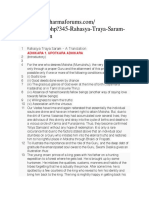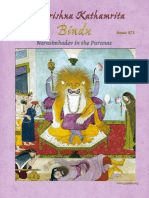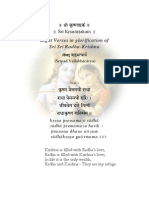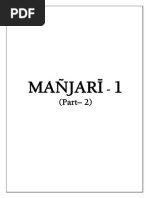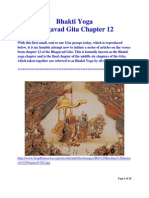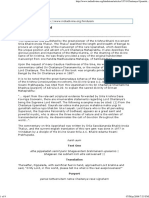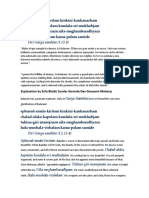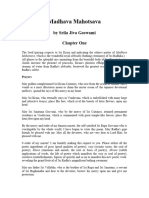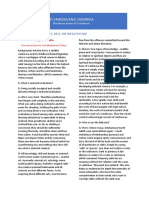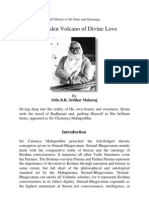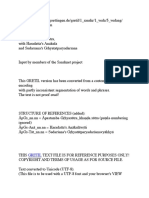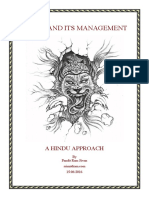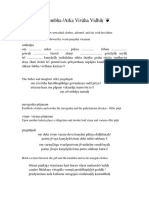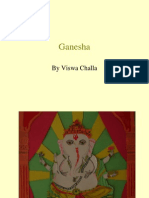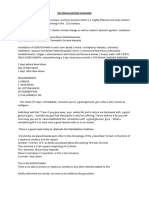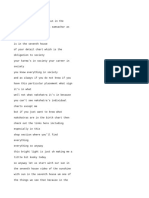Facebook On Radhas Feet
Facebook On Radhas Feet
Uploaded by
Gaura KeshavaCopyright:
Available Formats
Facebook On Radhas Feet
Facebook On Radhas Feet
Uploaded by
Gaura KeshavaOriginal Description:
Original Title
Copyright
Available Formats
Share this document
Did you find this document useful?
Is this content inappropriate?
Copyright:
Available Formats
Facebook On Radhas Feet
Facebook On Radhas Feet
Uploaded by
Gaura KeshavaCopyright:
Available Formats
There are a few different points being taken up by different devotees here.
First I want to agree with Hctor Rosario that the letter from Prabhupada is ONLY about seeing the feet not touching the feet which is a completely different matter. Touching of deities feet or any other part of the deity is in most parts of India ONLY done by a pujari. The exceptions to this as noted by Hari Prada Ds are in some temples in Maharastra and Orissa (Vittala and Puri Jagannatha) where visiting devotees can perform Sparshan (touching) of the deity as well as the normal Darshan (seeing and being seen by the deity). Concerning this tradition in some places of touching of deities by those who are not pujaris. The idea seems to be that the deity is pure and by touching the deity one also becomes pure. However normally the idea is that one (even a pujari) is not pure and should become pure first before touching the deity. In either case the idea is that contamination and purity is spread by touch. In our Vaisnava sampradayas mostly it is explained that one must first be purified by the pancaratric samskara of diksha before being allowed to touch the body of the deity (and also for other things that require one to be sanctified). Secondly even after diksha one should be physically pure by taking proper ritual bath, wearing proper ritual attire, tilaka, etc. before going and approaching the deity. Even after this a system of proper mental attitude by mentally destroying the impure physical body of the devotee and creating a completely pure spiritual body called Bhuta Suddhi is gone through before the pujari touches the deity. Thereafter the pujari will respectfully take permission from his guru parampara to approach and serve the deity directly. All these steps are normally gone through before one can approach the deity. The idea that female deity's feet should not be touched by a male pujari is not correct. There was no restriction like this spoken of by Prabhupada. In fact Prabhupada mentioned that the pujari should/must touch the feet of the deity. No exception for female deities was ever mentioned by him. Every person who actually has experience with worshiping the deity knows that when waking the deity the system is to enter the deity room, light or adjust the lamps or turn on the (electric) lights, then wake the small utsava/festival deities who are laying in bed by ringing a bell in the left hand and touching their feet with his right hand while chanting the specific prayer for waking that deity. This includes female deities. Of course there are some groups/sampradayas where the mere clapping of the hands three times are considered enough to wake the deities or at least announce the pujaris coming into the deity's bed chamber. So again regarding the worship of female deities by males and male deities by females normally this is not a factor because the pujari does not worship the deities in his or her physical body but in a pure spiritual body appropriate for doing that personal worship created by the process of Bhuta Suddhi in Vaidhi bhakti and in his Siddhadeha or spiritual form in Raganuga bhakti. We should also note that the pujari is to meditate on himself or herself as being a pure servant of the deities and not simply as a material male or female. Spiritually the individual souls are all considered as "female" in the sense that we are all
dependent and meant to serve the deities. Iconography 101: Regarding the point about markings on the feet of deities. In fact it is possible to see some markings on the soles (bottoms) of deities feet if their feet are not completely flat and connected to their pitham or base. For example a deity of baby Krishna lying on His back on a banyan leaf sucking His toe (Vattapatrasayi Krishna). Many deities of Lord Krishna in the tribanga (standing three fold bending) pose will have His right foot elevated so only the toes are flat on the base. Many deity makers do mark the bottom of this (right) foot. Similarly they also mark the Lord's chest with a footprint called Brighu pada or the footprint of Brighu Muni who kicked Lord Visnu in the chest. Srivatsa markings are also normal on the right side of any Visnu tattva deities chest as are Kaustubha markings on the left side or center. It is also common that markings are shown on the hands of deities. Actually although some deities in North India have lines on their hand the sastra mandates only auspicious symbols and sometimes lotus like diagrams in the center of their palms. This is because the deity has no karma. The lines on the hand are defined by one's karma therefore no deity can have lines on his hand like ordinary jivatmans. (This standard is followed even when making of deities of purva/previous acharyas in South India, the idea being that these acharyas having attained moksha no longer can be shown with signs of karmas on their hands). Back to the main topic of showing of feet. In South India and in most temples in North female deities are dressed quite conservatively. This is part of Indian culture. The feet of female deities is never shown for this reason. Even men in South India sometimes wear a vesti/lunghi very low in order to cover even their feet. The feet in India have some cultural significances. First since they are touching the ground they are considered as dirty, thus we often hear of people washing their feet when entering certain places like homes or temples. Indeed some temples have tanks and other apparatus for pilgrims to at least wash their feet before entering. Using others shoes is considered as not acceptable and dirty also. Padya is a special washing service offered to the deities for washing their feet. Whereas in the west we never really consider washing the feet separately from bathing the whole body (except on rare occasions of stepping in something dirty). Since the feet are considered as dirty one should not sit in such a way as to point one's feet to anyone or any deity. Surrender to a person in India is symbolized by falling at their feet, sometimes by touching their feet with one's hand or head. Holy persons as well as deities who visit are welcomed with their feet being washed and the holy water is then sprinkled and in some cases drunk by the hosts. The Lord's bathing water is in fact called caranamrta which literally means "the nectar from the feet" even though it contains not only water (Padya) used for washing His feet but also the rest of His body as well. So we can see that the feet are not only seen as dirty but also the place where one must go to surrender and attain the mercy of the person. Despite this females are supposed to be dressed conservatively not showing the feet. In North India we see female deities with their saris covering their heads which is the custom since the Muslim invasions of around 1000 ce. In South India in contrast this
custom of covering the head by females is not common amongst the people in general so similarly isn't done when dressing female deities either. Prabhupada had certainly made reference to covering of the head of female deities in accordance with North Indian custom. He also instructed us not to show female deities hair. Womens hair (even men's hair) in India is normally tied up in a braid (male's sikhas are tied by not in a braid). Thus the modern western tradition of untied hair is not to be used when dressing female deities. The next point I want to stress is that Prabhupada always told us that our worship of Radha Krishna in ISKCON was to be done in the mood of Laksmi Narayana. Radha Krishna live in a rural area where they would have been adorned with simple village garb and forest flowers. Krishna is described as having a bamboo flute. Yet ISKCON deities are dressed in the finest of silks with many jewels and golden or silver flutes. Indeed even the Gopa dressing of Radha shown by Visuddha-sattva Das in another posting shows her with a gold flute. This is mixture of rasas. Otherwise known as rasabhasa. The mood of Vrndavan is very simple rural mood. Thus sometimes we see in temples like Radha Raman the deity wears shorts or even only kaupina (underwear) on hot summer days. But the worship in awe and reverence or opulence of Laksmi Narayana in Vaikuntha does not allows such intimate displays. So one rasa or taste is the opulent taste of aishvarya with awe and reverence and the other is the sweet simple taste of rural cowherd community. The difference in this taste or rasa is determined by the attitude of the worshiper. Now some devotees may personally be advanced enough to manifest that attitude of sweet simple rural style worship which accompanies the worship of the Lord in Raganuga bhakti. But Prabhupada wanted that only the mood of aishvarya or opulence and awe and reverence be displayed in the public temples of ISKCON. So while I have no problem which such intimate displays being made by advanced raganuga bhaktas in their personal home worship. The ISKCON temple worship of Radha Krishna is supposed always to be done according to the principles and rasa/taste of Vaidhi bhakti. Now I would perhaps make an exception for the temple in Vrndavan itself where the other traditional major temples are perhaps doing some dressing in different moods on specific occasions only. Of course during Prabhupada's time we did not do this because he specifically ordered us to worship Radha Krishna in the mood of Laksmi Narayana. Still even if we disregard this and make some exceptions to this prohibition on occasions like Radhastami or Gopastami still this must be understood to be an exception to the rule not to be emulated in each and very place in the ISKCON world. One can perhaps justify dressing Radha as a cowboy in Vrndavan but how can it be justified in LA? Of course I expect many may disagree with me. And I would remind them to think of what Prabhupada himself would say if we dressed Radha as a cowboy in LA? I am not against displays of raganuga worship only that it should be in ISKCON limited to personal deities and not transferred to the worship standard of the ISKCON temple which was clearly defined by Prabhupada.
There are other customs that have been adopted into ISKCON temple worship that do not even conform to Vaisnava practice at all. The one that comes to mind is the dressing of Jagannath and Balarama as Ganesha after the Snana Yatra ritual. This is a custom adopted from the temple in Puri where the deity worship is not purely Vaisnava. It was first performed to appease a great mayavadi devotee of Ganapati (Ganesha). As such this custom finds no place in Vaisnava worship whatsoever, neither in Vaidhi nor Raganuga forms of worship. Secondly even if it is attempted to be explained away by some persons as only dressing as elephants for some lila (a form of Raganuga worship) still it completely misleads members of the Indian community when they come to ISKCON temples around the world (like London, Melbourne, etc) and see it. These Hindu guests certainly do not see Gaja (Elephant) dress as simply a lila of Krishna and Balarama but instead instantly identify the deity on the altar with the elephant head as Ganesha. Thus their idea that Krishna and Ganesha are equal become reinforced. This is hardly the preaching that we in ISKCON want to present to the world. There are many other changes in deity worship that could be discussed but let us suffice it to say that it seems that the leadership of ISKCON has not taken seriously these changes that have crept in or endeavored to discuss and examine whether or not they are beneficial to ISKCON's peaching mission or even bonafide from a perspective of Vaisnava siddhanta. Nimai Charan Das-Neeraj Wadehra Normally we see only auspicious symbols on the feet of different personalities. Krishna's face and His name are non-different from Him. If they are depicted on anyone's feet even Sri Radhas would that person not be walking on the Lord's face and name? Is that not offensive? For this reason I doubt very much that such representations are bonafide. We should look in sastra (silpa and agama) that describes deities for the symbols and signs on different personalities bodies. As I stated above this is Iconography 101. For example there is a Tamil Saivite Saint called Tiru Jnana Sambandar who looks exactly like Lord Krishna dancing but Iconographically one can tell the difference between a dancing child Krishna deity and a deity of this Saiva Saint ONLY by which leg is raised in the air. see http://en.wikipedia.org/wiki/Sambandar Similarly there are certain weapons and other things held in the hands of deities and poses of the hands (mudras) that indicate what the name of the deity is. One might see a deity and think that it is one personality and not notice that it has not got the defining markings or accessories and is actually another personality. Here's something to ponder over. The Gaudiya concept (and indeed the concept of the main three Vaisnava sampradayas of North India, Gaudiya, Vallabha and Nimbarka) is that Lord Krishna is the avatari or source of all incarnations. Whereas the older forms of Vaisnavism followed in South India i.e. Ramanuja and Madhva sampradayas concept as well as the general understanding of most Hindus is that Krishna is an avatar of Visnu. We do not need to argue this point here. However when people have tried to argue this
question with me I make some observations. 1. If Visnu is an avatar and Krishna is the original then why is there an appearance day when Krishna appeared (descended, the word avatar means literally one who descends) and yet no appearance day of Visnu or day when he descended? 2. Why do we speak of Visnu tattva as a category of deity? Should not the deity category be Krishna tattva and Visnu belong to it and not the other way around that Krishna belongs to the Visnu tattva category? 3. Why do we call ourselves as Vaisnavas and not Krishnavas? Surely if Krishna is the original (paradigm) then all those who follow Him are Krishnavas even those who worship His avatars Rama and Visnu. But if Visnu is the paradign or avatari then it makes sense that even followers and worshipers of Rama and Krishna are called Vaisnavas. 4. Iconographically all Visnu tattva deities have the marking of Srivatsa or Laksmi on the right side of their chest. This is the mark of Sri or Laksmi not Radha. If Krishna is the paradigm or avatari then should not the Srivatsa be called the Radha-vatsa? And should not all Rama and Visnu deities have a Radha-vatsa? 5. There is also a marking of the footprint of Brghu Muni called the Brghu pada on all deities of Visnu. The lila is that Brghu kicked Visnu in the chest. These markings are even seen on Krishna deities made in Vrndavan. Yet the mark was made on the chest of Visnu? Therefore the deities made in Vrndavan that correctly show this marking on the chest of Krishna because it is mandated by agama and silpa sastra are showing us that Krishna is a form of Visnu and not the other way around. 6. Why did Krishna appear in Mathura and manifest four arms a Visnu trait before becoming transforming into a small child form? If the original form is the teenage Krishna form then surely He would have manifest that teenage Krishna form first to show Devaki and Vasudeva who He was before changing into a baby form. 7. It is to be noted that there is no baby form of Visnu. Visnu always appears as a fully mature form. Only in the avataras do we see that the Lord first appears in a young form which then manifests the appearance of growth as the lila of the avatara unfolds. Does this also not show that Krishna who appeared as a child and manifest the appearance of growth at least to the teenage youthful age is an avatar and not the avatari
You might also like
- Dharma Sindhu PDFDocument425 pagesDharma Sindhu PDFGaura Keshava70% (10)
- Anyone Who Has Taken Birth As A Human Being In India Bharata-BhumiFrom EverandAnyone Who Has Taken Birth As A Human Being In India Bharata-BhumiNo ratings yet
- Rahasya Traya SaramDocument55 pagesRahasya Traya SaramGaura Keshava100% (4)
- Ekadasi by Jayatirtha Carana DasDocument41 pagesEkadasi by Jayatirtha Carana DasGaura Keshava100% (1)
- Vaikhanasa Agama KosaDocument34 pagesVaikhanasa Agama KosaGaura KeshavaNo ratings yet
- Gopal Sahasranam Sanskrit PDFDocument3 pagesGopal Sahasranam Sanskrit PDFMilanNo ratings yet
- Prameya RatnavaliDocument36 pagesPrameya Ratnavaliscooty.ram8447No ratings yet
- Canto 10Document812 pagesCanto 10puneet bhayanaNo ratings yet
- Sri Krishna Kathamrita - Bindu573-Lord NarasimhaDocument21 pagesSri Krishna Kathamrita - Bindu573-Lord NarasimhaOmm Prasad SwainNo ratings yet
- Bhaktivinoda ThakurDocument5 pagesBhaktivinoda ThakurDevotionalMellowsNo ratings yet
- Radha KirtiDocument37 pagesRadha KirtiRahul GhoshNo ratings yet
- Radha-Krsna Arcana DipikaDocument27 pagesRadha-Krsna Arcana DipikaОльгаNo ratings yet
- Sri Adikeshava Temple at ThiruvattarDocument53 pagesSri Adikeshava Temple at ThiruvattarchandanyatradasNo ratings yet
- Sri Sri Radha MadanmohanDocument11 pagesSri Sri Radha MadanmohanManu ChaudharyNo ratings yet
- Harihara: The Glories ofDocument73 pagesHarihara: The Glories ofsrinivas_kul100% (1)
- Gaudiya Vaisnava MantrasDocument13 pagesGaudiya Vaisnava MantrasVitor GasparNo ratings yet
- Krishnashtakam - VallabhacharyaDocument6 pagesKrishnashtakam - Vallabhacharyaआर्यकेशNo ratings yet
- Comparative Philosophy 1Document10 pagesComparative Philosophy 1Keshvanand DasNo ratings yet
- Sri Slokamritam PDFDocument293 pagesSri Slokamritam PDFAjitānanda DāsaNo ratings yet
- Manjari1 Part2Document11 pagesManjari1 Part2vishalg_4No ratings yet
- Madhava, Nilamadhava and Shree JagannathDocument3 pagesMadhava, Nilamadhava and Shree JagannathsingingdrumNo ratings yet
- Bhakti Yoga Bhagavad Gita Chapter 12: Cts Arjuna 2.jpgDocument35 pagesBhakti Yoga Bhagavad Gita Chapter 12: Cts Arjuna 2.jpgvlaxmananNo ratings yet
- Siddhanta Ratnam An Introducti Baladeva VidyabhusanaDocument586 pagesSiddhanta Ratnam An Introducti Baladeva VidyabhusanaSauri ChaitanyaNo ratings yet
- Chaitanya UpanishadDocument9 pagesChaitanya Upanishadbose123456No ratings yet
- VrindavanaDocument12 pagesVrindavanaChandraNo ratings yet
- Vyasadeva Jiva-Tattva or Vishnu-TattvaDocument7 pagesVyasadeva Jiva-Tattva or Vishnu-TattvaJohn BrownNo ratings yet
- Prayers in SBDocument22 pagesPrayers in SBmilandeep1990No ratings yet
- D3lqewxj Lakshmi Narayana Stotram in TeluguDocument6 pagesD3lqewxj Lakshmi Narayana Stotram in TeluguAnjali0% (2)
- Sri Guru Darshanam An Anthology of Questions and Answers With Shri Hari Das Shastri MaharajaDocument518 pagesSri Guru Darshanam An Anthology of Questions and Answers With Shri Hari Das Shastri MaharajaBishwadeep RoyNo ratings yet
- Sri Radhikastakam KDKGDocument2 pagesSri Radhikastakam KDKGapi-19975968No ratings yet
- Hari Bhakti SudhaDocument77 pagesHari Bhakti SudhaPrahladadasaNo ratings yet
- Frequently Asked Questions To Distribute Srimad Bhagavatam 01Document45 pagesFrequently Asked Questions To Distribute Srimad Bhagavatam 01jagan.yesNo ratings yet
- Glories On Yamuna - Haridas Varya DasDocument18 pagesGlories On Yamuna - Haridas Varya Dasmaverick6912No ratings yet
- Sri Gopal-CampuDocument39 pagesSri Gopal-CampuIronChavesNo ratings yet
- Manjari1 Part1Document12 pagesManjari1 Part1vishalg_4100% (1)
- Balaram PranamDocument2 pagesBalaram PranamEsteban Ariza RangelNo ratings yet
- Kanyakumari YatraDocument42 pagesKanyakumari YatrachandanyatradasNo ratings yet
- Glories of Mantra RajasDocument26 pagesGlories of Mantra RajasstomacoNo ratings yet
- Rama 1Document5 pagesRama 1hari18No ratings yet
- Rémad Hägavatam: Çrémad Bhägavatam: A Symphony of Commentaries On The Tenth CantoDocument801 pagesRémad Hägavatam: Çrémad Bhägavatam: A Symphony of Commentaries On The Tenth CantoAvirupNo ratings yet
- What Is AmDocument11 pagesWhat Is AmvasubvNo ratings yet
- Prema Bhakti Chandrika Sloka 22Document5 pagesPrema Bhakti Chandrika Sloka 22Jirka Luboš PřevorovskýNo ratings yet
- Dasa Mula TattvaDocument142 pagesDasa Mula TattvamahaphalaNo ratings yet
- 02 AnarthasDocument26 pages02 AnarthasAnonymous rYAbrelvgNo ratings yet
- About Srimati VrindaDocument13 pagesAbout Srimati VrindagopalguruNo ratings yet
- Madhava MahotsavaDocument77 pagesMadhava Mahotsavarokoyit861No ratings yet
- Vishvanatha Chakravarti Th.Document3 pagesVishvanatha Chakravarti Th.HarshitaNo ratings yet
- Sri Vrindavan Candrika - The Moonbeam of Vrindavan - Issue No 3 Sri KatyayaniDocument4 pagesSri Vrindavan Candrika - The Moonbeam of Vrindavan - Issue No 3 Sri Katyayaniom godboleNo ratings yet
- Golden VolcanoDocument132 pagesGolden Volcanoshantidevidasi2593No ratings yet
- Manifiesto VaisnavaDocument5 pagesManifiesto Vaisnavasama_dasaNo ratings yet
- PaddhatiDocument212 pagesPaddhatiBodi Sattva100% (1)
- Vaisnava-Vandana - Jiva GosvaminDocument9 pagesVaisnava-Vandana - Jiva GosvaminJohn SonNo ratings yet
- Sanatana Goswami Sri Brhad Bhagavatamrta PDFDocument997 pagesSanatana Goswami Sri Brhad Bhagavatamrta PDFmahaphalaNo ratings yet
- Is Lord Vishnu An Avatar of KrishnaDocument865 pagesIs Lord Vishnu An Avatar of KrishnaBishwadeep RoyNo ratings yet
- Parikrama Khanda NavadvipDocument42 pagesParikrama Khanda NavadvipMayank DixitNo ratings yet
- Hari Hara KsetraDocument5 pagesHari Hara KsetrachandanyatradasNo ratings yet
- NBS#236Document5 pagesNBS#236Nityam Bhagavata-sevaya E-magazineNo ratings yet
- Srimad Bhagavad-Gita - The Hidden Treasure of The Sweet AbsoluteDocument4 pagesSrimad Bhagavad-Gita - The Hidden Treasure of The Sweet AbsoluteDharanidhâr CøølNo ratings yet
- ISKCON Desire Tree - Gaudiya Vaisnava NectarDocument15 pagesISKCON Desire Tree - Gaudiya Vaisnava NectarISKCON desire treeNo ratings yet
- Sri Sri Prapanna-JivanamrtamDocument174 pagesSri Sri Prapanna-JivanamrtamharibhaktaNo ratings yet
- Vidyāpati: Bangīya padābali; songs of the love of Rādhā and KrishnaFrom EverandVidyāpati: Bangīya padābali; songs of the love of Rādhā and KrishnaNo ratings yet
- Witness to a Temple The Hare Krishna Movement in Auckland 1972-2004From EverandWitness to a Temple The Hare Krishna Movement in Auckland 1972-2004No ratings yet
- Grha Arca PratisthaDocument10 pagesGrha Arca PratisthaGaura Keshava0% (1)
- Padma Purana 6uttaraDocument1,094 pagesPadma Purana 6uttaraSankar SusarlaNo ratings yet
- Apastamba Grha Sutras With CommentariesDocument483 pagesApastamba Grha Sutras With CommentariesGaura KeshavaNo ratings yet
- Simple Suggested For Nila MadhavaDocument6 pagesSimple Suggested For Nila MadhavaGaura KeshavaNo ratings yet
- All HBV Gopal Mantra NyasasDocument120 pagesAll HBV Gopal Mantra NyasasGaura KeshavaNo ratings yet
- How To Reinstall Chuwi HI12Document5 pagesHow To Reinstall Chuwi HI12Gaura Keshava50% (2)
- Udaka Śānti PrayogaḥDocument35 pagesUdaka Śānti PrayogaḥGaura KeshavaNo ratings yet
- Kali Santarana UpanisadDocument3 pagesKali Santarana UpanisadMurugesan Raju100% (1)
- Puruṣa-Sūkta CommentaryDocument43 pagesPuruṣa-Sūkta CommentaryGaura KeshavaNo ratings yet
- Goloka Is A Material PlanetDocument6 pagesGoloka Is A Material PlanetGaura KeshavaNo ratings yet
- Agni Muk HamDocument3 pagesAgni Muk HamGaura KeshavaNo ratings yet
- Hari Bhakti Vilasa On Guru QualificationDocument9 pagesHari Bhakti Vilasa On Guru QualificationGaura KeshavaNo ratings yet
- AngerDocument23 pagesAngerGaura Keshava100% (1)
- Homosexuals in Mesopotamian LiteratureDocument6 pagesHomosexuals in Mesopotamian LiteratureGaura KeshavaNo ratings yet
- Pancharatra PrayogaDocument103 pagesPancharatra PrayogaGaura Keshava100% (2)
- Parasara SmrtiDocument2 pagesParasara SmrtiGaura KeshavaNo ratings yet
- Kumbha Vivaha VidhiDocument3 pagesKumbha Vivaha VidhiGaura Keshava86% (7)
- Writing Japa of Nitai PramanasDocument6 pagesWriting Japa of Nitai PramanasGaura KeshavaNo ratings yet
- Sri Sukta AccentDocument6 pagesSri Sukta AccentGaura KeshavaNo ratings yet
- Non-Initiates Performing Arcana - The Hare Krishna ForumDocument53 pagesNon-Initiates Performing Arcana - The Hare Krishna ForumGaura KeshavaNo ratings yet
- NMMC SlumDocument2 pagesNMMC SlumThapa SNo ratings yet
- GaneshaDocument20 pagesGaneshaMahima AgarwalNo ratings yet
- Q1Document7 pagesQ1Dr.Rathod RanjithNo ratings yet
- SC MeritDocument50 pagesSC MeritRahul DaveNo ratings yet
- Sri Mahalakshmi SadhanaDocument3 pagesSri Mahalakshmi SadhanaSrivarnikha ParthasarathyNo ratings yet
- Karnataka PGCET 2018 SamplesDocument20 pagesKarnataka PGCET 2018 Samplesphone2hireNo ratings yet
- Lord NandiDocument2 pagesLord NandivoxpapuliNo ratings yet
- International Shark Attack File (Isaf) : DefactoiasDocument7 pagesInternational Shark Attack File (Isaf) : DefactoiasramanNo ratings yet
- Details of Akhuwat Loan Centers PDFDocument30 pagesDetails of Akhuwat Loan Centers PDFAbc100% (1)
- Question Bank NODDocument7 pagesQuestion Bank NODree100% (1)
- 20 Appendices PDFDocument100 pages20 Appendices PDFmind freakNo ratings yet
- Indian HR Samples AutosavedDocument10 pagesIndian HR Samples AutosavedmaheshsasNo ratings yet
- Travel Outlook Telangana FoodDocument7 pagesTravel Outlook Telangana FoodtailenderNo ratings yet
- Narnala Wild Life Sanctuary by Ms Imtienla AoDocument28 pagesNarnala Wild Life Sanctuary by Ms Imtienla AoNikhilesh KumarNo ratings yet
- DSE Brochure 14-15Document68 pagesDSE Brochure 14-15Ravish RanaNo ratings yet
- Network Agnihotra Carinthia: Mary Magdalene SchleicherDocument2 pagesNetwork Agnihotra Carinthia: Mary Magdalene SchleicherChris BoweNo ratings yet
- Asian Age - Delhi - 2019-05-02 PDFDocument16 pagesAsian Age - Delhi - 2019-05-02 PDFNguwruw Chungpha Moyon100% (1)
- Sun in The 7th House of D10 Dashamsa Chart in Vedic Astrology - English - Generated)Document5 pagesSun in The 7th House of D10 Dashamsa Chart in Vedic Astrology - English - Generated)Ashraf KhamisaNo ratings yet
- Student List Inspire Manak Award 2020Document288 pagesStudent List Inspire Manak Award 2020Utkarsh Kamal100% (1)
- Jataka Tales - The Hidden TreasureDocument36 pagesJataka Tales - The Hidden TreasureChitra Rangarajan100% (8)
- New Microsoft Word DocumentDocument5 pagesNew Microsoft Word DocumentVeronica Delos SantosNo ratings yet
- II B.tech I Sem (2019-20) On Rolls FinalDocument17 pagesII B.tech I Sem (2019-20) On Rolls FinalK V BALARAMAKRISHNANo ratings yet
- S.No Hospital Name Address City Pin Code Tel - NoDocument4 pagesS.No Hospital Name Address City Pin Code Tel - NoJSM MKZYNo ratings yet
- Invitation CardDocument3 pagesInvitation Card05. Sehnaz MirzaNo ratings yet
- ThiruvadiDocument2 pagesThiruvadiUma MaheswariNo ratings yet
- Bhahawapra 1Document3 pagesBhahawapra 1Gabriel NedelcuNo ratings yet
- Kashmir YatraDocument31 pagesKashmir YatrachandanyatradasNo ratings yet
- Procedure of Havan, Havan Vidhi, Havan Mantra, How To Do Havan at Home - Rudraksha RatnaDocument10 pagesProcedure of Havan, Havan Vidhi, Havan Mantra, How To Do Havan at Home - Rudraksha RatnadikshaNo ratings yet
- ET SCM&Logistics SummitDocument8 pagesET SCM&Logistics SummitSagar ShindeNo ratings yet
- Panaji Goa Gynae and Obs SocietyDocument15 pagesPanaji Goa Gynae and Obs SocietyAMOLNo ratings yet


